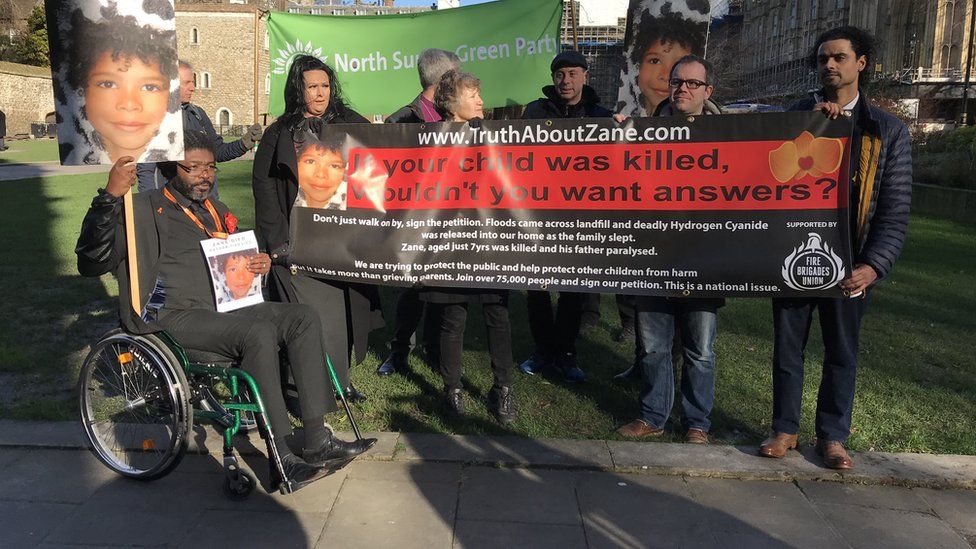Concerns were raised in 2010 over a former landfill site which later became the focus of a dispute over a seven-year-old’s death, it has emerged.
Zane Gbangbola died during flooding in 2014. His parents say he was killed by gas washed out of the Chertsey dump.
Spelthorne council recently discussed the concerns raised in a 2010 report, but said it may not be made public.
The council said studies since 2014 showed the site carried “less potential risk” than previously thought.
Zane’s parents, Kye Gbangbola and Nicole Lawler, dispute an inquest which found their son died from carbon monoxide from a pump used to clear flood water, and have always said the pump was not in use.

The 2010 report was prepared as part of a planning application by the Environment Agency to rebuild a lock keeper’s hut next door to Zane’s house.
It was not publicly available on Spelthorne Borough Council’s planning portal, but the BBC obtained a copy from the authority.
The document said “potential contaminants of concern” from the historic landfill site included carbon dioxide and methane generated by landfill material, as well as leachable contaminants such as heavy metals.
‘Danger is great’
The BBC showed a copy to environmental expert Paul Mobbs who said it was not based on any specific data but rather information about how the land was used.
He said the land had an unlined landfill site next to five metres of uncemented gravel which was in contact with the Thames, and the landfill would at some point leak.
Mr Mobbs warned: “At some point there will be another flood and then it will happen all over again.”
At a recent council meeting it was revealed several families were taken to hospital on the night Zane died.
Mr Gbangbola said the site was dangerous, adding: “The land has migrating gases and the danger is great to properties during floods.”
 IMAGE SOURCE,GETTY IMAGES
IMAGE SOURCE,GETTY IMAGESA spokesman for Spelthorne council said officers carried out an assessment after Zane’s death to determine whether the landfill site contained “substances and a pathway that could cause significant harm to people and/or the environment”.
He said no evidence was found to suggest this was the case.
The 2010 report was based on information known at the time, when it was assumed the site contained Class 2 waste, the spokesman added.
“Since 2014, further information has been gathered as a result of the council’s work mentioned. The result of this shows that the type of waste accepted at the site was actually Class 1 type waste and not Class 2. Class 1 waste carries less potential risk.”
He said the assumption that there was Class 2 waste in the dump could have led the authors of the 2010 report to be “overly precautionary in their conclusion”.
The BBC has gone back to the council to ask when the new information was gathered, where it came from, whether it followed a desk-top study or site investigation, whether it relates to an existing or historic waste licence and what action followed as a result of the findings.
A spokesman for the coroner said “an independent, full, frank and fearless inquest” concluded in 2016 and heard from more than 70 witnesses over six weeks.
The spokesman added: “Having considered all the evidence that was before the court, the coroner concluded that the cause of Zane’s death was carbon monoxide toxicity. We would like to offer our sincere condolences to Zane’s family and friends.”
An Environment Agency spokesman said: “Our thoughts remain with the Gbangbola family. During the inquest the Environment Agency provided evidence to assist the independent coroner in reaching his conclusions.”



No comments:
Post a Comment
Note: only a member of this blog may post a comment.